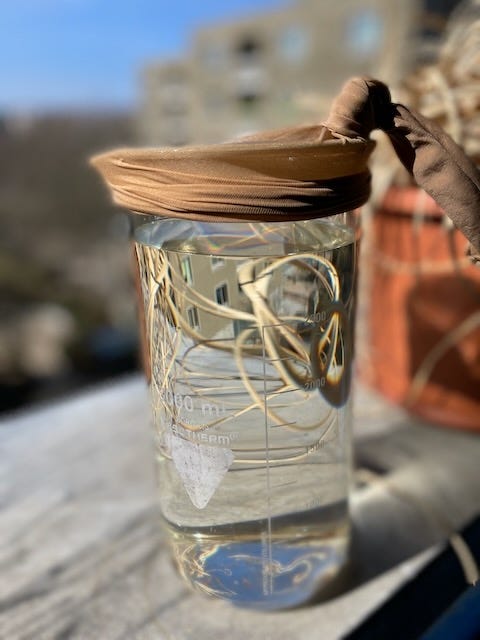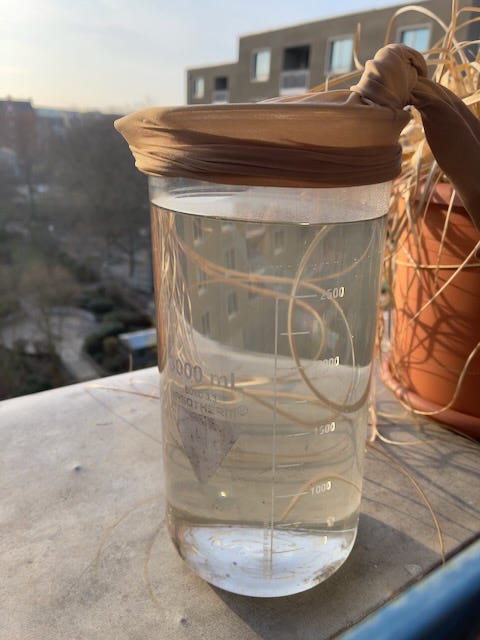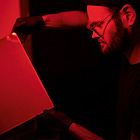Maintaining the silver bath for collodion wetplate photography
Part 2: the routine maintenance after several plates
In part 1 of this short series I introduced some basic information about silver nitrate baths for collodion wetplate photography.
This part 2 will cover the routine maintenance that I do on a regular basis. How often you do that, depends on the plate size and of course the number of plates you pour. I do this light maintenance after like 10-20 5x7” and/or 8x10” plates in 2l of silver bath.
The chemical background
The so called double decomposition (old term) or metathesis reaction is the core mechanism for all silver based photographic processes. Two reactants, silver nitrate (AgNO3) and and an iodine of e.g. potassium (KI) form light sensitive AgI (silver iodine) and KNO3 (potassium nitrate). Here is the formula:
AgNO3+KI→AgI+KNO3
This also counts for bromide salts (for example KBr) used in the collodion solution, forming AgBr and KNO3.
In other words, if you dip a plate with collodion in a silver nitrate bath, you will get a plate full of silver iodines (AgI) and silver bromides (AgBr). Your silver nitrate bath on the other hand will be contaminated with several ingredients, such as:
organic substances like dust, hair… : the source of every artifact like comets…
ether: will destabilize collodion when too much is present
alcohol: from the collodion, will affect developer distribution on the plate
nitrate compounds: will slowly lower pH and make the bath more acid
silver iodines and bromides: will be present in the solution as well
Some of those ingredients can be removed with the basic maintenance, some need a bit more effort to remove. And by the way: I am not a chemist!
Sunning the silver bath
The rays of the sun are quite powerful, as we know from our latest sun burn. The most effective way to treat a silver nitrate bath is sunning it.
Get a large glass vase with a big opening (for example a big pickle jar glass) and fill your silver nitrate bath into the container. Please be aware to wear safety googles and gloves! Then, cover the glass with a nylon cloth and put it into the sunlight for several hours or days. Over the time, the silver bath will get grey and it will also loose some water due to evaporation.


Sunning the silver bath is the most effective way to prepare the removal of organic substances.
Tiny organic particles are being exposed and can be filtered afterwards.
Depending the temperature you are sunning your silver, the ether will be removed. Ether has a boiling temperature of 35°C, so if you sun your silver on a summer day, all of the ether will be evaporated.
On the other hand, alcohol’s boiling point is 78°C, so sunning alone won’t help to remove all, but a bit will also be evaporated.
Sunning also removes acids like nitric acids, regulating the pH of the bath.
Finishing the light maintenance
When you realize that the grayness of the silver nitrate solution does not change anymore, it is time to filter it. I always you a cotton pad that you find in nearly every supermarket around the globe - just squeeze it in the funnel and let the silver nitrate run through. You will need to filter at least 4 times, to take your time and don’t hurry: silver nitrate is expensive and every drop you loose costs you money.
Now your silver nitrate solution is free of organic particles, only one thing is left to do: checking the gravity of your solution. You can read how that works in the first part of this series:
I always check if the pH ranges from 3-4 with a litmus strip and then, the silver nitrate is ready for the next plates.
What’s next?
From time to time, you may notice some problems like pinholes or other issues. If you can nail it down, that the silver nitrate is the culprit, it’s maybe time to think about a heavy maintenance. I will cover my heavy silver bath maintenance routine in the next and probably last episode of this series.
If you want to learn the wet collodion process or if you want to improve your technique, feel free to check out my upcoming workshops.
That’s for it now, see you next time.
Max




